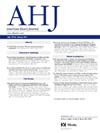70岁或以下严重主动脉狭窄患者的经导管或手术主动脉瓣置换术-一项notion2亚研究
IF 3.7
2区 医学
Q1 CARDIAC & CARDIOVASCULAR SYSTEMS
引用次数: 0
摘要
这项noto -2亚研究揭示了年龄≤70岁三尖瓣或二尖瓣主动脉瓣狭窄(AS)的低手术风险患者经导管主动脉瓣置换术(TAVR)和手术主动脉瓣置换术(SAVR)的不同结果。干预一年后,与SAVR相比,TAVR后三尖瓣AS患者的死亡、卒中或再住院风险相似(绝对风险差:-2.0%;95%可信区间(CI): -11.8%至7.7%)相反,在双尖瓣AS患者中,TAVR与不良结局的风险显著升高相关(绝对风险差:13.8%;95% CI: 1.2% ~ 26.3%)。这些分析是探索性的,但强调了根据患者的临床风险概况、预期寿命、原生主动脉瓣形态以及与TAVR或SAVR相关的预期风险量身定制干预措施的重要性。试验注册号:ClinicalTrials.gov NCT02825134。本文章由计算机程序翻译,如有差异,请以英文原文为准。
Transcatheter or surgical aortic valve replacement in patients with severe aortic stenosis aged 70 years or younger: A NOTION-2 substudy
This NOTION-2 sub-study revealed distinct outcomes for transcatheter aortic valve replacement (TAVR) and surgical aortic valve replacement (SAVR) in low surgical risk patients aged ≤ 70 years with a tricuspid or bicuspid aortic valve stenosis (AS). One year after intervention, the risk of death, stroke or rehospitalization in patients with tricuspid AS was similar after TAVR when compared to SAVR (absolute risk difference: −2.0%; 95% confidence interval (CI): −11.8% to 7.7%) Conversely, in patients with bicuspid AS, TAVR was associated with a significantly higher risk of adverse outcomes (absolute risk difference: 13.8%; 95% CI: 1.2% to 26.3%). These analyses are exploratory, but highlight the importance of tailoring the intervention to the patient's clinical risk profile, life expectancy, native aortic valve morphology and the anticipated risks associated with TAVR or SAVR.
求助全文
通过发布文献求助,成功后即可免费获取论文全文。
去求助
来源期刊

American heart journal
医学-心血管系统
CiteScore
8.20
自引率
2.10%
发文量
214
审稿时长
38 days
期刊介绍:
The American Heart Journal will consider for publication suitable articles on topics pertaining to the broad discipline of cardiovascular disease. Our goal is to provide the reader primary investigation, scholarly review, and opinion concerning the practice of cardiovascular medicine. We especially encourage submission of 3 types of reports that are not frequently seen in cardiovascular journals: negative clinical studies, reports on study designs, and studies involving the organization of medical care. The Journal does not accept individual case reports or original articles involving bench laboratory or animal research.
 求助内容:
求助内容: 应助结果提醒方式:
应助结果提醒方式:


